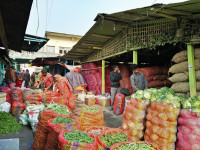National
Government begins setting standards to curb excessive market layers and price distortion
A new framework aims to control middlemen, ensure fair pricing, and protect producers and consumers as multi-layered supply chains inflate costs across Nepal.
Krishana Prasain
Seven years after the Consumer Protection Act 2018 came into force, the government has begun drafting standards to define market layers and regulate the pricing of goods and services.
The Department of Commerce, Supplies and Consumer Protection has formed a committee led by its director general, with representatives from the private sector and other stakeholders. The team will prepare a study report to establish standards for determining market structures and pricing systems.
Through these standards, the department plans to clearly define the roles of producers, wholesalers, retailers and service providers. Officials say the framework is intended to bring uniformity in price determination, improve transparency and regulation, support price control measures and strengthen consumer protection, while also guiding market solutions and rules.
Consumer rights activists say the absence of market-level standards has allowed middlemen to profit disproportionately, leaving producers—especially those of agricultural goods—at a loss and forcing consumers to pay inflated prices.
“Currently, supply chains sometimes involve seven to eight layers. The goal is to reduce unnecessary intermediaries between producers and consumers so that producers receive fair value for their goods and consumers get relief,” said Bishnu Prasad Timilsina, general secretary of the Forum for Protection of Consumer Rights-Nepal.
He said that maximum retail prices should be set by calculating production costs and adding a transparent profit margin. “Once the government sets standards for market layers and prices, it will help eliminate the middlemen who profit without investing capital or labour,” he added.
According to a report by the department, goods and services in Nepal typically pass through up to seven middlemen, each adding significant markups.
Multi-layered supply chains are especially common in agricultural trade. A product priced at Rs10 at the farm gate can reach Rs70 by the time it reaches consumers.
In many sectors, products move from the manufacturer to the dealer, main distributor, national distributor, local distributor, wholesaler and retailer before reaching buyers.
In April 2022, the department drafted a proposal to legally define the layers of middlemen involved in distributing essential goods, but the effort stalled amid frequent changes in government and bureaucracy.
Consumers say retail prices of vegetables vary widely by location, but not everyone has the time to visit wholesale markets. For example, a kilogram of cauliflower priced at Rs50 at the Kalimati Fruits and Vegetable Market often sells for up to Rs150 in retail shops.
Consumer rights advocates say the upcoming standards should help ease price pressures on daily essentials, whose costs often rise sharply under various pretexts.
Bikram Limbu Chemjong, vice-president of the Nepal Bottled Water Industries Association, said maximum retail prices should reflect product quality to protect public health. “If factories fail to meet standards, they should face action instead of compromising on quality and price,” he said. Producing quality goods is expensive, so pricing must be studied carefully, he added.
Experts say both producers and consumers in the agricultural sector suffer from black marketing, artificial shortages, price hikes and other market anomalies. They argue that syndicate-like operations in supply chains allow a few sellers and middlemen to control the market.
“Nepal operates through syndicates, so markets do not function competitively. The private sector seeks protection rather than pursuing competitiveness through innovation, which has stalled progress for years,” said Nara Bahadur Thapa, former executive director of Nepal Rastra Bank.
Thapa said reference prices for essential goods—such as rice, edible oil and vegetables—could help control inflation. He added that the government should support the private sector-led market development by constructing vegetable and grain markets similar to India’s ‘mandis’ across the country. These hubs, he said, attract more sellers and foster competitive pricing.
Investment in cold storage facilities would also help stabilise market prices, he said. “Government investment in developing and promoting markets plays a key role in determining market layers and prices.”




 19.12°C Kathmandu
19.12°C Kathmandu















